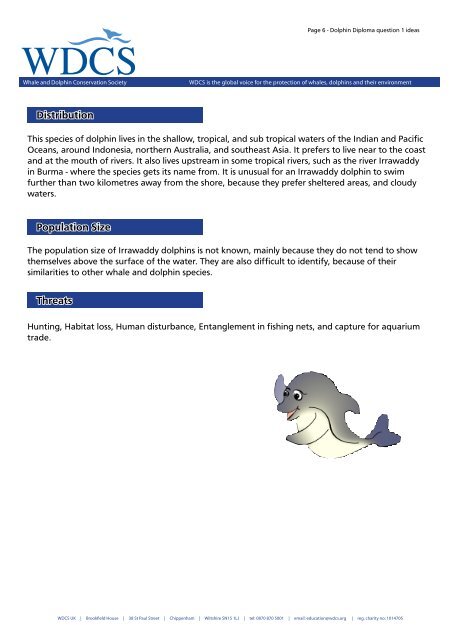Linked activity for Q1.pdf - Whale and Dolphin Conservation Society
Linked activity for Q1.pdf - Whale and Dolphin Conservation Society
Linked activity for Q1.pdf - Whale and Dolphin Conservation Society
You also want an ePaper? Increase the reach of your titles
YUMPU automatically turns print PDFs into web optimized ePapers that Google loves.
Page 6 - <strong>Dolphin</strong> Diploma question 1 ideas<strong>Whale</strong> <strong>and</strong> <strong>Dolphin</strong> <strong>Conservation</strong> <strong>Society</strong>WDCS is the global voice <strong>for</strong> the protection of whales, dolphins <strong>and</strong> their environmentDistributionThis species of dolphin lives in the shallow, tropical, <strong>and</strong> sub tropical waters of the Indian <strong>and</strong> PacificOceans, around Indonesia, northern Australia, <strong>and</strong> southeast Asia. It prefers to live near to the coast<strong>and</strong> at the mouth of rivers. It also lives upstream in some tropical rivers, such as the river Irrawaddyin Burma - where the species gets its name from. It is unusual <strong>for</strong> an Irrawaddy dolphin to swimfurther than two kilometres away from the shore, because they prefer sheltered areas, <strong>and</strong> cloudywaters.Population SizeThe population size of Irrawaddy dolphins is not known, mainly because they do not tend to showthemselves above the surface of the water. They are also difficult to identify, because of theirsimilarities to other whale <strong>and</strong> dolphin species.ThreatsHunting, Habitat loss, Human disturbance, Entanglement in fishing nets, <strong>and</strong> capture <strong>for</strong> aquariumtrade.WDCS UK | Brookfield House | 38 St Paul Street | Chippenham | Wiltshire SN15 1LJ | tel: 0870 870 5001 | email: education@wdcs.org | reg. charity no: 1014705
















